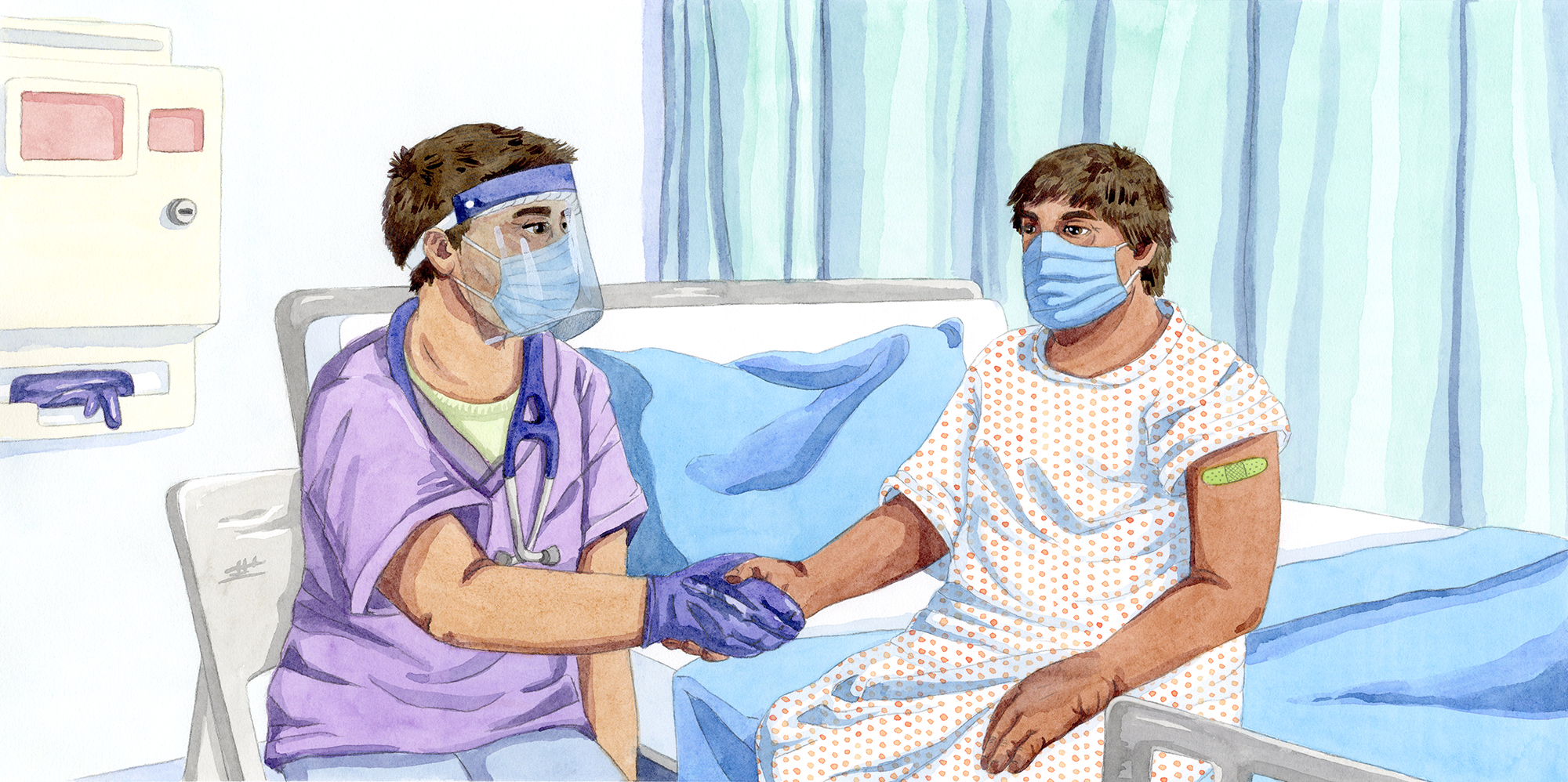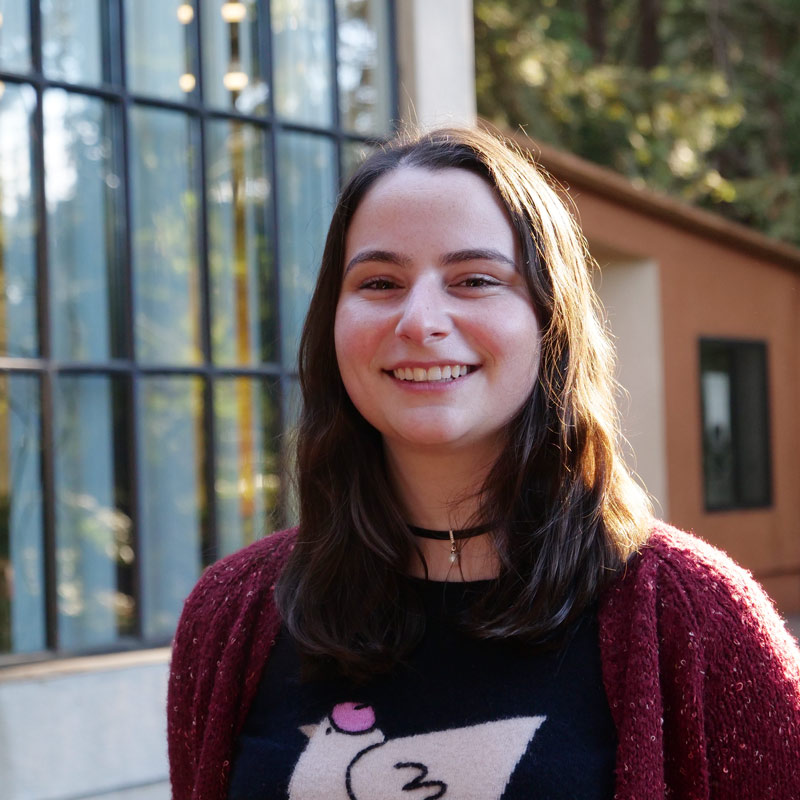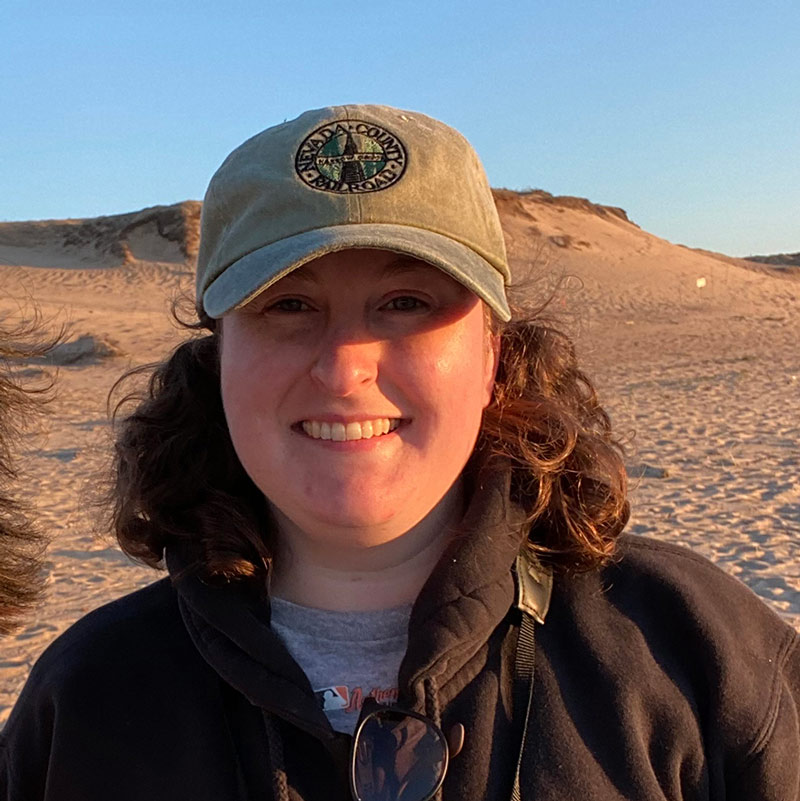A treatment for mistrust
Megan Kalomiris reports how doctors and researchers are working to reach and protect the underserved in the wake of the COVID-19 pandemic. Illustrated by Emma Oyle.

Illustration: Emma Oyle
In July of 2020, Dr. Robert Rodriguez traveled from San Francisco to his hometown of Brownsville, Texas– but he wasn’t going to his home. This visit was bleak. Overrun by COVID-19, doctors in the ICU were facing six times as many patients as normal – at least. Being a generally underserved community, Brownsville did not have the resources to help everybody who needed it, so the hospital was overwhelmed. State congressperson and district representative of Brownsville, Filemon Vela, called for additional assistance. Vela called on Rodriguez, as they were childhood friends, and Rodriguez rose to the occasion.
Outside the hospital, Valley Baptist Medical Center, masked locals sang hymns and prayers in support of the patients and workers inside. Inside the hospital, Rodriguez confronted an air of overwhelm and the unfamiliar faces of strangers, entirely covered in protective wear. All he could see of their faces were their eyes.
Since visitors weren’t allowed, the nurses provided tablets for the patients to meet with their families over video. Sometimes nurses needed to prop the tablet up on a surface next to a patient’s hospital bed, as the patient was too ill to hold it. In some cases, doctors and nurses called patients’ families on the phone, telling them that their loved ones were going to die.
“It was definitely the hardest work experience of my career,” Rodriguez says.
At the end of each shift, Rodriguez would stay at Vela’s Brownsville home – it was just blocks away from his family’s home, yet he could not go there. He wouldn’t dare expose them to the virus in any way, after everything he’d seen, especially since some family members were at high risk of severe COVID. The best he could do was to visit his father outdoors in the evenings, standing masked and 12 feet away – just to be sure.
This heavy experience left Rodriguez with three take-home messages: healthcare workers need better support, underserved populations need more support and vaccine efforts absolutely must target the underserved when the vaccines are available.
Now, Rodriguez has assembled a team of investigators across the U.S. to fix this discrepancy.
In 2021, Rodriguez concluded a study finding that those lacking primary care are more hesitant towards COVID-19 vaccination than those who have primary care. In a new study launched in December of 2021, he is testing communication methods to ease vaccine concerns, and working to make vaccination available in the ER.
With one-quarter of Americans remaining unvaccinated against the virus that continues to ravage the world, it is still essential to find the remaining sources of vaccine hesitancy and address them. Most underserved populations – including Black people, Latinx people, the unhoused, the impoverished and undocumented immigrants – seek medical services in emergency rooms because they do not have health insurance or primary care. Almost 1 in 4 Americans don’t have a primary care provider, and 1 in 5 do not have health insurance. A 2019 survey run by the Department of Health and Human Services revealed that over 30 million people under the age of 65 were left uninsured. This large population is where Rodriguez is focusing his efforts.
Rodriguez emphasized how much the available COVID-19 vaccines have transformed the hospital’s COVID wards in general, as they are now far less scary. But for many, vaccine hesitancy – or choosing not to get vaccinated – stands in the way of that reduced risk.
Those who are vaccine-hesitant are not staunchly against vaccination, but rather those whose questions and concerns stand in the way – at varying degrees – of electing to vaccinate. These roadblocks range from wondering if the vaccine is safe to wondering if the vaccine is necessary for them. Some may even wonder how they find an appointment or may simply not be ready to get one.
But COVID vaccine hesitancy puts the hesitant in danger during this pandemic. The COVID death rate in the U.S. for the unvaccinated is 6.6 times higher than for the fully vaccinated and 27 times higher than the vaccinated and boosted. Researchers have also found that vaccination reduces the likelihood of developing Long COVID – lingering COVID symptoms that range from mild to debilitating – by about half.
COVID vaccine hesitancy is a collective danger as well as an individual one. COVID vaccination provides varying protection from infection based on vaccination type and number of doses received. Therefore, remaining unvaccinated heightens the risk of becoming infected with the virus, and thus passing it on to others.
“We’re still seeing large volumes of patients are coming into our emergency departments…and there is a subset of populations that are going to get really sick and die, require hospitalizations, and so forth,” said Jesus Torres, an investigator on the study assessing vaccine hesitancy. “We have some of the best vaccines ever made – there is just a lot of misunderstanding and misinformation.”
The unfortunate reality is that the underserved populations who could benefit most from efforts to combat vaccine hesitancy are least likely to be included in those efforts because many have limited access to phone or internet services.
“[Rodriguez’s] study led to COVID vaccines being administered in emergency rooms in a major way, which at one point we weren’t doing that,” said Torres. “And now we are.”
A tale of two cities
Rodriguez has also been working to address the basic healthcare needs of those who visit the emergency department since the beginning of his career in medicine. He explained that there are groups of people who are only able to access healthcare in the ER – often underserved groups in society. Without health insurance, they have nowhere else to go. Because of this, a longtime goal of Rodriguez and other researchers of emergency medicine has been to find ways to offer care in the ER that an insured person would typically receive through their primary care physician.
“The emergency room serves everyone – period – for anything, at any time, no matter what,” Torres said. “[These groups] tend to seek care in the emergency room, and the emergency room acts like a point of entry to the health care system.”
In 2005, Rodriguez began working at UCSF. Fifteen years later, when the COVID-19 pandemic began, Rodriguez predicted that the groups relying on the ER for healthcare would be the same groups disproportionately impacted by the illness – and he was correct. He saw the discrepancy firsthand when he left his hometown of Brownsville to return to the San Francisco Bay Area. For instance, pre-pandemic median household income in San Francisco and Brownsville was about $112,000 and $40,000 respectively. And by September 2020, 91 people had died of COVID in San Francisco, compared to 843 in Brownsville.
“There was 10 times the number of deaths in a population that’s about half the size of San Francisco,” he said. “It’s tragic that there are such disparities.”
This stark comparison weighed on him in addition to the tumultuous setting of the Brownsville hospital in which he assisted. Upon his return, he wrote about his experience and thoughts on potential solutions.
One week after the 2020 presidential election, Rodriguez was appointed to the Biden-Harris Administration COVID-19 Health Equity Task Force, where he tried to draw attention to the needs of those failed by the U.S. healthcare system. Then, in December of 2020, COVID-19 vaccines finally became available. Rodriguez and his team worked diligently to study how underserved populations would respond to the vaccine, focusing on the ER.
Asking the unheard
Once studies on vaccine hesitancy started rolling out, Rodriguez noticed a trend that gave him pause – many of these studies relied on internet surveys. The populations he was paying attention to often did not readily have internet access, and some did not even have phones, he noted. He suspected many of these people were left out of these studies, and they may have higher levels of vaccine hesitancy than those who weren’t left out.
“And so, we performed a study to assess those problems, the barriers of vaccine access, and vaccine hesitancy,” he said. “Otherwise, their voices would not be heard.”
This study, called the REVVED UP Study, aimed to examine vaccine trends specifically in underserved populations that lack access to regular healthcare, and compare their trends to those with primary care.
Rodriguez created a team of investigators at 15 ER sites in 14 cities across the country: five on the West Coast, three in the Midwest, five on the east coast, and one in the South.
Almost anyone who walked into these 15 emergency departments would have the opportunity to participate. All they needed to do was consent and complete a short survey. Rodriguez and his team recruited 2,301 such participants: some eager to get vaccinated, some not; some part of an underserved social group, some not. In all sites except two, at least 50% of participants turned to the ER for their typical source of healthcare.
Rodriguez summarizes three points of importance in the results: those without primary care are almost 20% more likely to be vaccine-hesitant than those with primary care, he has a better idea of why those without primary care are hesitant, and those who want the vaccine would take it in the ER.
The main reasons for hesitancy were largely similar between those with primary care and those without: including wanting more information about the vaccine, hearing media stories providing doubt, and having already been infected with the virus. The significant differences were that those lacking primary care were less likely to cite concerns of vaccine safety and more likely to cite not fearing COVID infection as reasons for not wanting the vaccine.
“They were spot on in anticipating this potential need for assessing ER patients and their vaccine perspectives and hesitancy,” said Michael Waxman, associate professor in emergency medicine at Albany Medical College, who is unaffiliated with the study. “And they really did a great job.”
Based on the results of that study, Rodriguez is now trying to find ways to address vaccination barriers.
“That’s what he is trying to do, trying to understand things, which is a critical first step in knowing how to fix something,” said Jerry Hoffman, Rodriguez’s first mentor.
Behind the apprehension
While the research team found that many concerns were similar between the two groups, those concerns may come from different places – as many participants relying on the ER were Black, Latinx, impoverished or a mixture of the factors.
Vaccine hesitancy is complex. People can be vaccine-hesitant for different reasons.
Some underserved populations that Rodriguez aims to reach have faced a long history of unethical mistreatment and racism. For instance, hospitals engage in “patient dumping,” or discharging impoverished or unhoused patients before they are fully stabilized. Undocumented immigrants face the possibility of being detained while under medical care. For instance, U.S. Immigration and Customs Enforcement (ICE) agents detained a Honduran man leaving a Pennsylvanian ER in March of 2020 – even though medical facilities are generally protected from ICE enforcement actions. Additionally, Black people have been the unwitting subjects of medical experimentation in America for centuries.
“When a person says that there’s a chip in the vaccine or that they’re trying to monitor my day-to-day activity, or other assumptions that some consider crazy, that is all against the backdrop of a history of just the lack of trust,” said Jonathan Butler, social epidemiologist at UCSF and vice president and health committee chair of NAACP. “And rightfully so.”
“When a person says that there’s a chip in the vaccine or that they’re trying to monitor my day-to-day activity, or other assumptions that some consider crazy, that is all against the backdrop of a history of just the lack of trust – and rightfully so.”
Hoffman echoes this sentiment. “I think that if you want to help our society, and particularly groups that have been marginalized, you want to help them get to a place where they are not so suspicious of authority, which they have plenty of reason to be,” he said. “[Vaccine hesitancy] has nothing to do with reason at all – my own personal opinion is that it has to do with trust.”
Fighting concerns
The natural next step beyond understanding the root of this vaccine hesitancy is working to address it. In May of 2021, Rodriguez and his team received a grant from the National Institutes of Health (NIH) to do just that.
The new project, called PROCOVAXED, started in December of 2021. Rodriguez and his team are specifically searching for unvaccinated visitors to the ERs at five hospitals across the country. Once consented and surveyed, the participants will receive informational messages that the PROCOVAXED team created based on the findings of Rodriguez’s previous study.
These messages take the form of informational videos, flyers and a face-to-face conversation with a nurse or other healthcare provider. There are five videos, one of which is in Spanish, each featuring medical professionals of different ethnicities.
After that, the provider offers the vaccine. If the participant refuses, the team calls them a month later to check if they changed their mind.
Butler has shown Rodriguez’s PROCOVAXED materials to eight members of his African American church coalition, and they had mixed feelings.
On the one hand, they found the content was straightforward and informative. On the other hand, they would prefer such information-dense content to be either broken down into shorter messages or just be a conversation with a trusted doctor.
“Again, there’s always on the backdrop of mistrust of doctors and the health care system,” Butler remarked. “So the more you can try to distill that [information] down a bit in terms of messaging, the more receptive communities will be.”
This feedback is helpful to the process of refining a helpful message. Rodriguez explains that he and his team will take what feedback they receive and adjust the informational materials accordingly.
Rodriguez says he simply hopes that this will work to get more vaccines into underserved arms.
Though he didn’t care for them directly in Brownsville, Rodriguez lost two friends to COVID-19 that summer.
“One guy was my next-door neighbor for a long time, taught me how to fish and things like that,” he said. “The other guy I’d play basketball with.”
Those two lives lost meant something to Rodriguez, and to others. But to those that didn’t know them, they are just numbers – two deaths. Every day that goes by, the U.S.’s death total ticks grimly onwards to a higher number. At the height of the worst waves, that number reaches over 2,000 per day, amounting to a year’s worth of flu deaths in a mere fortnight or less. The total toll currently rings at over one million in the U.S. alone – that’s higher than the population of San Francisco, where Rodriguez currently resides. That number doesn’t even begin to reflect everyone whose lives are forever altered by the virus, either by the death of a loved one, or those barely escaping death but bearing scars from the battle.
“Everybody has been, at some point, affected in that way,” Rodriguez remarked when talking about his two friends.
But it doesn’t have to be this way – not anymore. Heading into year three of this pandemic, we are equipped with knowledge and technology to shield against further damage. Vaccines, limiting gatherings, masking, testing and air filtration and ventilation are effective, necessary steps toward a time when this virus releases its claws from society.
As Rodriguez has found, it has its claws deeper in some sectors of society than others. But if he fulfills his goals, it won’t be that way for long.
© 2022 Megan Kalomiris / UC Santa Cruz Science Communication Program

Megan Kalomiris
Author
B.S. Biology, California State University, Fresno
Internships: Monterey Herald, Stanford News Service, Seymour Marine Discovery Center, Smithsonian Voices
“Everyone ready for the electrons?” the physicist called out. As he eagerly readied the voltage supply, I braced myself, holding hands with a string of other third-graders as we became an electrical circuit. We felt the harsh snap of electricity course through our bodies, screamed, and dissolved into boisterous giggles. Though I felt like my arms had just exploded, that lesson taught me two things I’d never forget—electric current stays constant throughout a circuit, and I had absolutely fallen in love with science.
I experienced the other side of that encounter years later. My college physics outreach course had us present a lesson to a hall of third graders. They were a fantastic crowd—engaged, curious, and erupting with enthusiasm. One boy even wet himself in excitement. And yet, I probably enjoyed the experience more than they did. As a science communicator, I aim to provoke lasting curiosity and engagement with science, hopefully without any further accidents (electrical or otherwise).

Emma Oyle
Illustrator
B.S. Ecology, Evolution, & Biodiversity, University of California, Davis
I was fortunate to grow up in a family that supported my interests in both science and art. When I discovered the profession of scientific illustration during my first year of college, my family continued to support me in deciding to make time in my STEM-based schedule for art classes. My self-confidence as an artist took a hit during the 2020 pandemic, and once again my family encouraged me to continue following my passions, and to apply for the CSUMB Science Illustration program. I am grateful to my lifelong support network, and I greatly look forward to starting my career as a science illustrator who helps to make science more accessible.